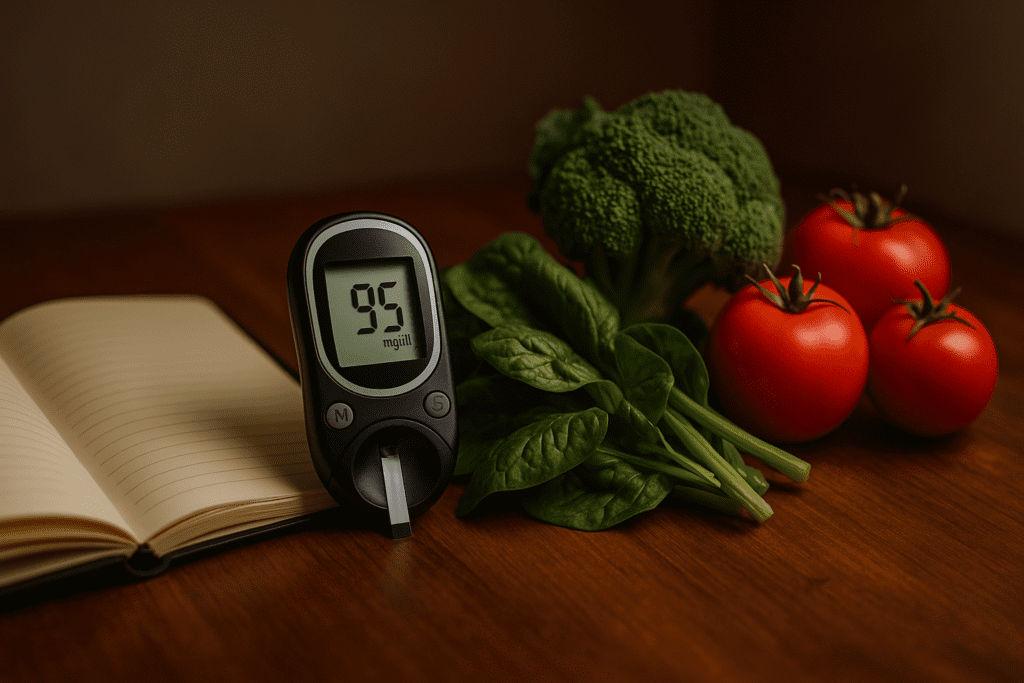Managing blood sugar levels is essential for individuals with diabetes, and diet plays a pivotal role in achieving this goal. Among the wide array of plant-based foods, vegetables offer a rich source of fiber, antioxidants, and essential nutrients that can help regulate blood glucose levels. However, not all vegetables have the same impact on blood sugar, and understanding which ones provide the greatest benefits can empower individuals to make informed dietary choices. This article explores some of the best vegetables for diabetes, with a focus on commonly consumed options such as tomatoes, spinach, and broccoli. We will delve into whether these vegetables are good for diabetes, clarify misconceptions, and highlight how they contribute to better blood sugar management.
You may also like: How a Vegan Diet Can Help Reverse Heart Disease: What the Science Says
Why Vegetables Are Essential for Diabetes Management
Vegetables are a cornerstone of any healthy diet, but they become even more vital for individuals managing diabetes. High in fiber, low in calories, and packed with essential vitamins and minerals, vegetables help maintain stable blood sugar levels and reduce the risk of diabetes-related complications. Fiber slows down the absorption of glucose in the bloodstream, preventing sudden spikes in blood sugar levels. Additionally, vegetables contain antioxidants that combat oxidative stress, a factor that contributes to insulin resistance.
Cruciferous vegetables like broccoli and leafy greens such as spinach have shown remarkable benefits for individuals with diabetes. These vegetables are low in glycemic load, meaning they have minimal impact on blood sugar. Including a variety of diabetic-friendly veggies in daily meals can enhance satiety, improve insulin sensitivity, and promote overall metabolic health. The inclusion of nutrient-dense, whole vegetables in a plant-based diet supports healthy weight management, another crucial factor in diabetes prevention and control.

Are Tomatoes Good for Diabetics? A Closer Look at Their Impact on Blood Sugar
Tomatoes, often debated in the context of diabetes, are indeed a nutrient powerhouse that offers several benefits. They are rich in vitamins A, C, and K, along with potassium and folate. Tomatoes also contain lycopene, a powerful antioxidant known for its anti-inflammatory properties. For individuals with diabetes, the good news is that tomatoes have a low glycemic index (GI) of around 15, making them a safe choice for maintaining stable blood sugar levels.
However, concerns about whether tomatoes are bad for diabetics arise due to their natural sugar content. While tomatoes contain a small amount of natural sugar, the fiber in tomatoes helps offset any potential blood sugar spike. Consuming fresh, whole tomatoes or using them in salads, sauces, or soups can be beneficial for blood sugar management. Studies suggest that the antioxidants in tomatoes may also reduce oxidative stress and inflammation, both of which are linked to diabetes-related complications.
The key is to consume tomatoes in their natural form rather than processed versions, such as ketchup or tomato-based sauces, which often contain added sugars and preservatives. Roasted tomatoes, cherry tomatoes, or tomato-based salads can be enjoyed freely without concerns about their impact on blood sugar levels.

Is Spinach Good for Diabetics? Unlocking the Nutritional Power of Leafy Greens
Spinach, a nutrient-dense leafy green, is another excellent choice for individuals with diabetes. Packed with vitamins A, C, and K, along with folate, magnesium, and potassium, spinach provides a range of health benefits. One of the primary reasons spinach for diabetes is recommended is due to its high fiber content and low carbohydrate load. Fiber slows the digestion of carbohydrates, preventing blood sugar spikes after meals.
Magnesium, abundantly present in spinach, plays a critical role in insulin sensitivity and glucose metabolism. Studies indicate that individuals with higher magnesium intake have a lower risk of developing type 2 diabetes. Additionally, spinach is rich in antioxidants, such as lutein and zeaxanthin, which protect the eyes—a concern for individuals with diabetes who may develop diabetic retinopathy.
Including spinach in daily meals is easy and versatile. Whether added to salads, blended into smoothies, sautéed with garlic, or used as a base for soups, spinach contributes to overall blood sugar stability. Spinach’s minimal effect on blood glucose, combined with its array of nutrients, makes it an indispensable vegetable for those aiming to manage diabetes effectively.

Is Broccoli Good for Diabetics? Exploring the Antioxidant and Fiber Benefits
Broccoli, a member of the cruciferous vegetable family, stands out as one of the most beneficial vegetables for diabetes management. Rich in fiber, vitamins C and K, and an impressive array of phytonutrients, broccoli offers a host of health benefits. One of the primary reasons broccoli is good for diabetics is its high sulforaphane content—a compound that has been shown to reduce inflammation and improve insulin sensitivity.
A clinical study published in Science Translational Medicine found that sulforaphane reduced glucose production in the liver and improved glucose tolerance in individuals with type 2 diabetes. Additionally, the fiber in broccoli slows digestion and prevents rapid blood sugar spikes after meals. Broccoli’s low glycemic index of around 10 ensures that it has a minimal impact on blood sugar levels.
Roasting, steaming, or stir-frying broccoli preserves its nutritional integrity and enhances its flavor. Adding garlic, olive oil, or lemon juice not only elevates the taste but also boosts its anti-inflammatory properties. For individuals wondering, “can diabetics eat broccoli?”—the answer is a resounding yes, with numerous health benefits in tow.
Are Peas Good for Diabetics? Understanding Their Role in Blood Sugar Management
Peas often fall into a gray area when it comes to diabetes management. While they are slightly higher in carbohydrates compared to other non-starchy vegetables, peas also contain a significant amount of fiber and protein. This combination helps slow down the absorption of glucose, reducing the likelihood of blood sugar spikes.
Green peas, in particular, have a moderate glycemic index of around 48, making them a relatively safe option for diabetics when consumed in moderation. Peas also contain vitamins A, C, and K, along with essential minerals like iron and magnesium. Their high fiber content contributes to satiety, making them a valuable addition to a balanced diabetic meal.
For individuals wondering, “can diabetics eat peas?”—the answer lies in portion control. Incorporating peas into soups, salads, or vegetable medleys can enhance nutrient intake without compromising blood sugar stability. However, it is advisable to avoid canned peas that may contain added salt or sugar, opting instead for fresh or frozen peas.
Are Tomatoes Bad for Diabetics? Addressing Misconceptions
The question of whether tomatoes are bad for diabetics often stems from a misunderstanding of their natural sugar content. While tomatoes contain a small amount of natural sugar, their overall carbohydrate content is minimal. The fiber in tomatoes slows down the absorption of sugar, preventing any significant impact on blood glucose levels.
Research indicates that the lycopene and antioxidants in tomatoes may even help reduce inflammation and lower the risk of cardiovascular disease, which is a common concern for individuals with diabetes. Consuming tomatoes in their raw, roasted, or cooked form provides a wealth of nutrients without contributing to blood sugar spikes. However, diabetics should avoid highly processed tomato products such as ketchup or pasta sauces that contain added sugars and sodium.
Can Diabetics Eat Broccoli? Exploring Its Protective Role
For those wondering, “can diabetics eat broccoli?”—the answer is unequivocally yes. Broccoli is not only safe but highly recommended for individuals managing diabetes. Its unique combination of fiber, antioxidants, and anti-inflammatory compounds makes it a powerhouse vegetable for blood sugar control. Sulforaphane, a key compound in broccoli, enhances the body’s detoxification pathways and reduces oxidative stress, both of which are beneficial for individuals with diabetes.
Broccoli can be easily incorporated into various dishes, from roasted sides and stir-fries to soups and casseroles. Pairing broccoli with healthy fats like olive oil or avocados enhances the absorption of its fat-soluble vitamins, providing maximum health benefits.
Is Kale Good for Diabetics? Examining the Benefits of This Nutrient-Dense Green
Kale, another leafy green superstar, offers immense benefits for individuals managing diabetes. Like spinach, kale is rich in fiber, vitamins A, C, and K, and antioxidants such as quercetin and kaempferol. Kale’s high fiber content slows down the digestion of carbohydrates, preventing sharp blood sugar spikes.
Additionally, kale contains alpha-lipoic acid, a compound that has shown potential in improving insulin sensitivity and reducing oxidative stress. This antioxidant effect can help mitigate complications associated with diabetes, such as neuropathy and cardiovascular disease. Whether consumed raw in salads, blended into smoothies, or sautéed with garlic, kale adds a nutritious punch to any diabetic-friendly meal.
Bad Vegetables for Diabetics: What to Limit or Avoid
While most vegetables are beneficial for individuals with diabetes, a few should be consumed in moderation due to their higher carbohydrate content. Starchy vegetables such as potatoes, corn, and sweet potatoes can cause rapid blood sugar spikes if consumed in large quantities. Although they contain valuable nutrients and fiber, portion control is key when incorporating these vegetables into a diabetes-friendly diet.
Processed or canned vegetables that contain added sugars, sodium, or preservatives should also be avoided. These additives can negate the health benefits of vegetables and contribute to increased blood pressure and blood sugar imbalances.
Best Grain and Legume for Diabetes: Balancing Fiber and Protein
In addition to vegetables, whole grains and legumes play a significant role in blood sugar management. Quinoa, barley, and brown rice are among the best grains for diabetes due to their high fiber content and low glycemic impact. Legumes such as lentils, chickpeas, and black beans are rich in protein and fiber, making them an excellent choice for maintaining satiety and stabilizing blood sugar levels.
Combining these grains and legumes with diabetic-friendly veggies enhances nutrient absorption and provides a balanced source of carbohydrates, fiber, and protein. This synergy supports sustained energy levels and prevents blood sugar fluctuations throughout the day.
Incorporating Diabetic-Friendly Veggies into Everyday Meals
Incorporating a variety of diabetic-friendly veggies into daily meals is easier than it seems. A colorful plate filled with spinach, kale, broccoli, tomatoes, and peas not only adds flavor and texture but also provides a diverse range of nutrients that support metabolic health. For breakfast, add sautéed spinach or kale to scrambled tofu or omelets. At lunch, enjoy a fresh salad with cherry tomatoes, cucumbers, and a sprinkle of nuts for added fiber and protein. For dinner, roast a medley of broccoli, bell peppers, and zucchini with olive oil and herbs to create a nutrient-dense side dish.
Here’s a comprehensive, SEO-optimized, and medically accurate FAQ section based on the provided article. This FAQ introduces fresh insights and perspectives beyond what was discussed in the main article, following all the specified guidelines.
FAQ: Best Vegetables for Diabetes: Are Tomatoes, Spinach, and Broccoli Good for Blood Sugar Control?
1. Are Tomatoes Good for Diabetics When Consumed Daily?
Yes, tomatoes can be an excellent choice for individuals with diabetes when consumed daily in moderate amounts. While some concerns arise due to the natural sugar content in tomatoes, the fiber, antioxidants, and essential nutrients present in tomatoes significantly outweigh any minor impact on blood sugar. Lycopene, a potent antioxidant found in tomatoes, has been linked to reduced inflammation and improved cardiovascular health, which is particularly beneficial for diabetics. Moreover, tomatoes have a glycemic index of around 15, making them a low-GI food that does not cause sudden spikes in blood sugar levels. For optimal benefits, opt for fresh or roasted tomatoes rather than highly processed forms like ketchup, which often contain added sugars. When asking, “are tomatoes okay for diabetics?” the answer is a resounding yes, as long as they are consumed in their whole, unprocessed form.
2. Is Spinach Good for Diabetics Trying to Manage Their Weight?
Absolutely. Spinach is a nutrient-dense, low-calorie vegetable that supports weight management, which is essential for diabetes control. High in fiber and low in carbohydrates, spinach promotes satiety and prevents overeating, helping individuals maintain a healthy weight. Additionally, spinach is packed with magnesium, a mineral that plays a crucial role in regulating blood sugar levels and improving insulin sensitivity. Consuming spinach for diabetes management can also protect against complications such as diabetic retinopathy, thanks to its high levels of lutein and zeaxanthin—antioxidants that support eye health. Whether consumed raw in salads, blended into smoothies, or sautéed with garlic, spinach offers a wealth of health benefits for diabetics seeking weight control and blood sugar stability.
3. Can Diabetics Eat Peas Without Experiencing Blood Sugar Spikes?
Yes, diabetics can enjoy peas in moderation without experiencing harmful blood sugar spikes. Although peas are slightly higher in carbohydrates compared to other non-starchy vegetables, their high fiber and protein content slows down the absorption of glucose, preventing rapid increases in blood sugar. Green peas have a moderate glycemic index (GI) of around 48, which makes them a relatively safe choice for those managing diabetes. Additionally, peas are rich in vitamins A, C, and K, as well as essential minerals such as magnesium and iron, which contribute to overall metabolic health. To incorporate peas effectively into a diabetic meal plan, consider adding them to soups, salads, or grain bowls. However, it’s best to choose fresh or frozen peas over canned varieties, as the latter may contain added sodium or sugar.
4. Is Broccoli Good for Diabetics Looking to Reduce Inflammation?
Yes, broccoli is one of the most effective vegetables for reducing inflammation in individuals with diabetes. This cruciferous vegetable is rich in sulforaphane, a bioactive compound known for its powerful anti-inflammatory and antioxidant properties. Studies suggest that sulforaphane may reduce oxidative stress and enhance insulin sensitivity, which is crucial for those managing diabetes. Furthermore, broccoli is high in fiber, which aids in maintaining steady blood sugar levels by slowing glucose absorption. Consuming steamed, roasted, or stir-fried broccoli regularly can help mitigate inflammation and lower the risk of diabetes-related complications such as cardiovascular disease. For individuals wondering, “is broccoli good for diabetics?”—the answer is not only yes but also highly recommended for its anti-inflammatory benefits.
5. Are Peas Good for Diabetics Following a Low-Glycemic Diet?
Yes, peas can be included in a low-glycemic diet designed for diabetes management, provided they are consumed in appropriate portions. With a moderate glycemic index of 48, peas offer a balance between carbohydrates, fiber, and protein that helps prevent rapid increases in blood sugar. Peas also contain resistant starch, which acts similarly to fiber by slowing digestion and improving insulin response. Including peas in a diabetic-friendly meal plan can add variety and provide essential nutrients such as vitamin C, vitamin K, and iron. When considering whether diabetes peas consumption aligns with a low-glycemic diet, moderation is key. Opt for fresh or frozen peas instead of canned versions to avoid unnecessary sodium and additives that may interfere with blood sugar control.
6. Are Tomatoes Bad for Diabetics with High Blood Pressure?
Tomatoes are not inherently bad for diabetics with high blood pressure; in fact, they may provide cardiovascular benefits. Rich in potassium, tomatoes help regulate blood pressure by counteracting the effects of sodium in the body. Lycopene, the antioxidant found in abundance in tomatoes, has been shown to reduce oxidative stress and lower the risk of heart disease—both critical concerns for individuals with diabetes. However, diabetics should be cautious when consuming processed tomato products, such as canned tomato sauce or ketchup, which often contain added salt and sugar that can contribute to high blood pressure. For optimal health, choose fresh tomatoes or low-sodium tomato products to enjoy their benefits without exacerbating hypertension.
7. What Is the Best Grain and Legume for Diabetes Control?
The best grain and legume for diabetes control include quinoa and lentils due to their impressive fiber content, low glycemic impact, and rich nutrient profile. Quinoa is a complete protein that provides all nine essential amino acids, making it an excellent choice for vegetarians and vegans managing diabetes. It is also high in fiber and has a low glycemic index, which helps prevent blood sugar spikes after meals. Similarly, lentils are packed with fiber, protein, and essential minerals like iron and magnesium, all of which support stable blood glucose levels. Including these nutrient-dense options in a diabetic-friendly diet promotes satiety, enhances insulin sensitivity, and reduces the risk of blood sugar fluctuations. When exploring the best grain and legume for diabetes, quinoa and lentils stand out for their remarkable health benefits.
8. Is Kale Good for Diabetics Concerned About Eye Health?
Yes, kale is an exceptional choice for diabetics concerned about preserving their eye health. Rich in antioxidants such as lutein and zeaxanthin, kale helps protect the retina from oxidative stress and reduces the risk of diabetic retinopathy—a common complication of diabetes that can lead to vision impairment. Additionally, kale is high in vitamin C, which strengthens the immune system and protects against inflammation that can exacerbate eye-related issues. Consuming kale regularly may also improve overall vascular health, which is essential for maintaining optimal blood flow to the eyes. For those asking, “is kale good for diabetics?”—it not only supports blood sugar control but also provides critical protection against diabetes-related eye conditions.
9. What Are Some Bad Vegetables for Diabetics to Limit?
While most vegetables are beneficial for individuals with diabetes, a few should be consumed in moderation due to their higher carbohydrate content. Starchy vegetables such as potatoes, corn, and sweet potatoes can cause rapid spikes in blood sugar if consumed in large quantities. Although these vegetables provide valuable nutrients and fiber, portion control is essential to prevent adverse effects on blood sugar levels. Canned or processed vegetables that contain added sugars, sodium, or preservatives can also pose risks by contributing to high blood pressure and metabolic imbalances. When considering bad vegetables for diabetics, it’s best to limit the intake of high-starch varieties and opt for fresh, whole vegetables that promote stable blood sugar levels.
10. Can Diabetics Eat Broccoli Alongside Whole Grains for Better Blood Sugar Control?
Yes, combining broccoli with whole grains can significantly enhance blood sugar control for diabetics. Broccoli’s high fiber content slows down the digestion of carbohydrates, preventing rapid blood sugar spikes after meals. When paired with whole grains such as quinoa, brown rice, or barley, the synergistic effect promotes satiety and stabilizes blood glucose levels over an extended period. Whole grains provide complex carbohydrates and additional fiber, which complement the nutritional benefits of broccoli. For those wondering, “can diabetics eat broccoli with grains to improve blood sugar management?”—this combination not only enhances nutrient absorption but also creates a balanced, diabetes-friendly meal that supports overall metabolic health.
Conclusion: Harnessing the Power of Vegetables for Optimal Blood Sugar Control
The journey to better blood sugar control begins with incorporating the right vegetables into your daily diet. Tomatoes, spinach, broccoli, peas, and kale offer a wealth of nutrients, fiber, and antioxidants that promote metabolic health and improve insulin sensitivity. Understanding the impact of these vegetables on blood sugar levels empowers individuals to make informed dietary choices and embrace a plant-based, whole-food lifestyle that supports long-term diabetes management. By combining these nutrient-dense vegetables with whole grains and legumes, individuals with diabetes can create balanced, satisfying meals that promote stable blood sugar levels and overall well-being.
vegetables for blood sugar control, low glycemic vegetables, plant-based diet for diabetes, antioxidant-rich foods, fiber for blood sugar management, cruciferous vegetables benefits, leafy greens for diabetes, lycopene and blood sugar, managing diabetes with diet, natural anti-inflammatory foods, best foods for insulin sensitivity, healthy meal planning for diabetics, nutrient-dense vegetables, eye health and diabetes, potassium-rich vegetables, diabetes-friendly cooking tips, vegetables that regulate blood sugar, heart health and diabetes, whole foods for diabetes management, benefits of sulforaphane
Further Reading:
The 10 Best Vegetables for Diabetes
The best vegetables for type 2 diabetes
7 Low-Carb Veggies for a Diabetes-Friendly Diet
Disclaimer
The information contained in this article is provided for general informational purposes only and is not intended to serve as medical, legal, or professional advice. While NewsHealthWatch strives to present accurate, up-to-date, and reliable content, no warranty or guarantee, expressed or implied, is made regarding the completeness, accuracy, or adequacy of the information provided. Readers are strongly advised to seek the guidance of a qualified healthcare provider or other relevant professionals before acting on any information contained in this article. NewsHealthWatch, its authors, editors, and contributors expressly disclaim any liability for any damages, losses, or consequences arising directly or indirectly from the use, interpretation, or reliance on any information presented herein. The views and opinions expressed in this article are those of the author(s) and do not necessarily reflect the official policies or positions of NewsHealthWatch.

